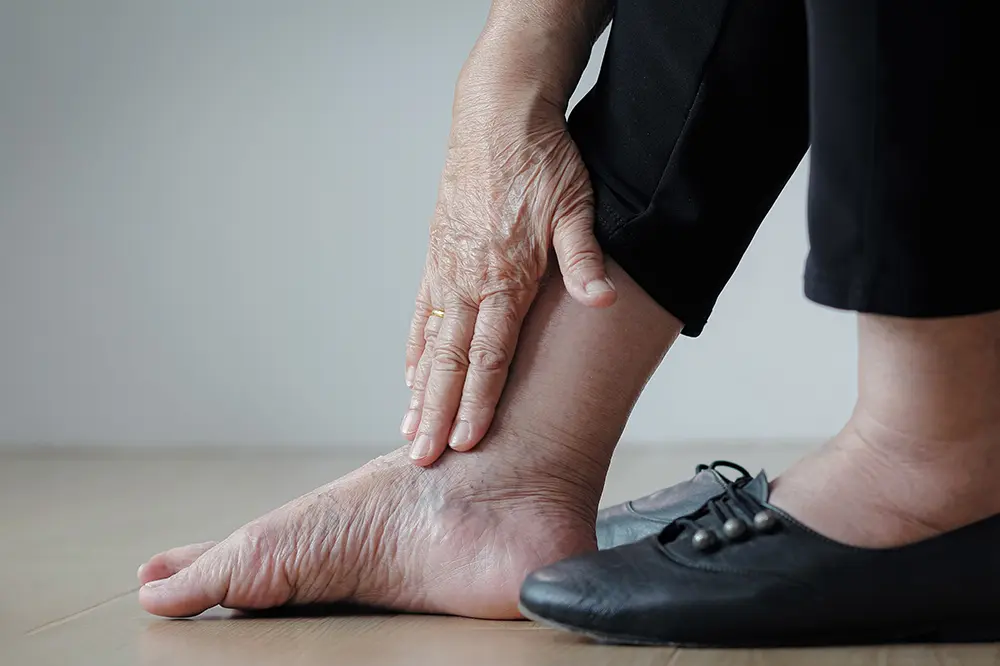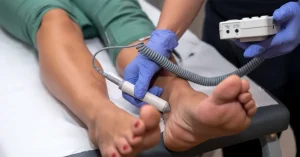Diabetic foot is one of the most common and serious complications of diabetes, and ignoring the symptoms can lead to severe infections, hospitalization, or even amputation. We are talking about lesions, wounds, or ulcers that appear on the feet, often accompanied by infections that progress rapidly if not treated in time. These problems occur because high blood sugar levels affect both the nerves and blood vessels. The result is decreased sensitivity in the lower limbs and poor circulation, creating a dangerous environment for wounds that heal slowly or not at all.
What Are the Symptoms of Diabetic Foot?
Early symptoms may include:
- Persistent numbness
- Unexplained tingling or pain
- Feeling of “dead feet”
- Gradual loss of touch or temperature sensation
What Causes Diabetic Foot?
Diabetic foot occurs as a result of complex changes caused by diabetes, especially when blood sugar is poorly controlled. The main causes include:
- Poor Circulation (Ischemia)
High blood sugar levels affect the blood vessels, narrowing them and reducing blood flow. Tissues receive less oxygen, wounds heal poorly, and the risk of infection increases significantly. - Diabetic Neuropathy
Damage to the peripheral nerves leads to loss of sensation. Pain, temperature, or pressure may no longer be felt, allowing small injuries to go unnoticed and become infected quickly. - Arterial Problems
Diabetes promotes the formation of atherosclerotic plaques, severely affecting circulation in the lower limbs. Consequences include slow healing, recurrent infections, ulcers, or even gangrene. - Frequent Infections
The weakened immune system in people with diabetes increases their vulnerability to infections. Untreated injuries can worsen, leading to deep infections or sepsis. - Foot Deformities and Localized Pressure
Diabetes can change the shape of the foot, such as hammer toes or fallen arches, creating areas of excessive pressure. These promote the development of calluses, ulcers, and chronic wounds, especially without proper footwear.
If you have been diagnosed with diabetes, take action early. Monitor your feet closely, attend regular check-ups, and follow your doctor’s advice to avoid complications such as:
- Diabetic foot
- Diabetic retinopathy (eye damage)
- Diabetic nephropathy (kidney damage)
Prevention and early intervention make the difference between simple treatment and major surgery. Talk to your doctor about assessing your risk of diabetic foot and the specific measures you should take daily.
Recognizing the Symptoms
If you have diabetes and notice changes in your feet, do not delay seeking medical advice. Diabetic foot often begins with subtle signs, but if left untreated, these can develop into severe infections or complications that endanger the affected limb. Watch for the following symptoms, which may indicate peripheral nerve damage or poor circulation:
- Numbness, tingling, or burning, especially at night
- Changes in skin color or temperature (cold, pale, or purple skin)
- Swelling of the foot or ankle
- Unexplained pain at rest or when walking
- Wounds that heal slowly, persistent discharge, or infections
- Ingrown toenails, corns, or painful calluses
- Very dry, cracked skin, especially on the heels
- Unpleasant odor that persists despite good hygiene
Do not wait until it becomes an emergency. At VenArt, our specialists provide comprehensive diabetic foot assessments and personalized treatments to prevent serious complications, including hospitalization or amputation.
How Can You Properly Care for Your Diabetic Foot? Recommendations from the VenArt Team
Daily Hygiene – The First Step in Prevention
Wash your feet daily with warm water and mild soap. Dry them thoroughly, especially between the toes. Avoid hot water and abrasive products.
Keep Your Diabetes Under Control
High blood sugar levels affect the nerves and blood vessels. Follow your prescribed treatment plan and monitor your blood sugar regularly.
Check Your Feet Every Day
Examine your feet in the morning and evening. Look for wounds, cracks, blisters, ingrown toenails, or color changes. Contact your doctor if you notice anything unusual.
Schedule an Annual Specialist Consultation
Even if you have no obvious symptoms, it is essential to have your feet checked at least once a year. At VenArt, we use modern diagnostic methods for early detection of complications.
Protect Your Feet Every Day
Wear comfortable, well-fitting shoes. Avoid going barefoot, exposure to extreme temperatures, and excessive moisture.
Have you noticed any changes in your feet? Schedule a specialist consultation at VenArt. Timely assessment can prevent serious consequences. Our multidisciplinary team is here to help you maintain foot health and prevent complications from diabetes.
Diabetic Foot Treatment – Timely Intervention Saves Mobility
Proper management of diabetic foot involves both medical treatment and, in some cases, surgery. The choice of therapy depends on the stage of the condition and how quickly you consult your doctor.
Medical Treatment – The First Step in Controlling Complications
Treatment begins with strict control of diabetes mellitus, the underlying cause of the condition. Plans are individualized and determined by your diabetes doctor based on your needs and disease stage. The main methods include:
- Administration of oral antidiabetic drugs
- Insulin therapy when necessary
- Use of approved adjuvant supplements, such as Diabetvital, burdock tincture, or black mulberry bud extract
A balanced, sugar-free diet based on foods allowed in the diabetic diet is essential. Proper treatment combined with careful foot hygiene significantly reduces the risk of ulcers, infections, and local complications.
If you notice signs of local infection, such as redness, discharge, or pain, see a doctor immediately. Infections require prompt antibiotic treatment. Warning: treating diabetic foot using only natural methods or without medical supervision can worsen the condition and lead to limb loss. Always consult a specialist.
Surgical Treatment – When Every Hour Counts
In cases where infection has progressed aggressively, surgery may be necessary. The surgeon decides the appropriate procedure based on lesion severity. Interventions may include:
- Incision and drainage of abscesses
- Debridement of infected tissue
- Revascularization, performed by a vascular surgeon to restore blood flow and improve healing
Conclusion
Diabetic foot is a complex condition with the potential to endanger mobility and overall health. Prevention, careful monitoring, and prompt treatment are essential to avoid serious outcomes, including severe infections or amputation.
At VenArt, we combine multidisciplinary expertise with modern diagnostic and treatment methods to protect foot health. With correct assessment and timely intervention, you can maintain mobility, independence, and quality of life. Do not delay your consultation—every day counts when it comes to foot health in diabetes. Schedule a consultation with us and see how we can help.











